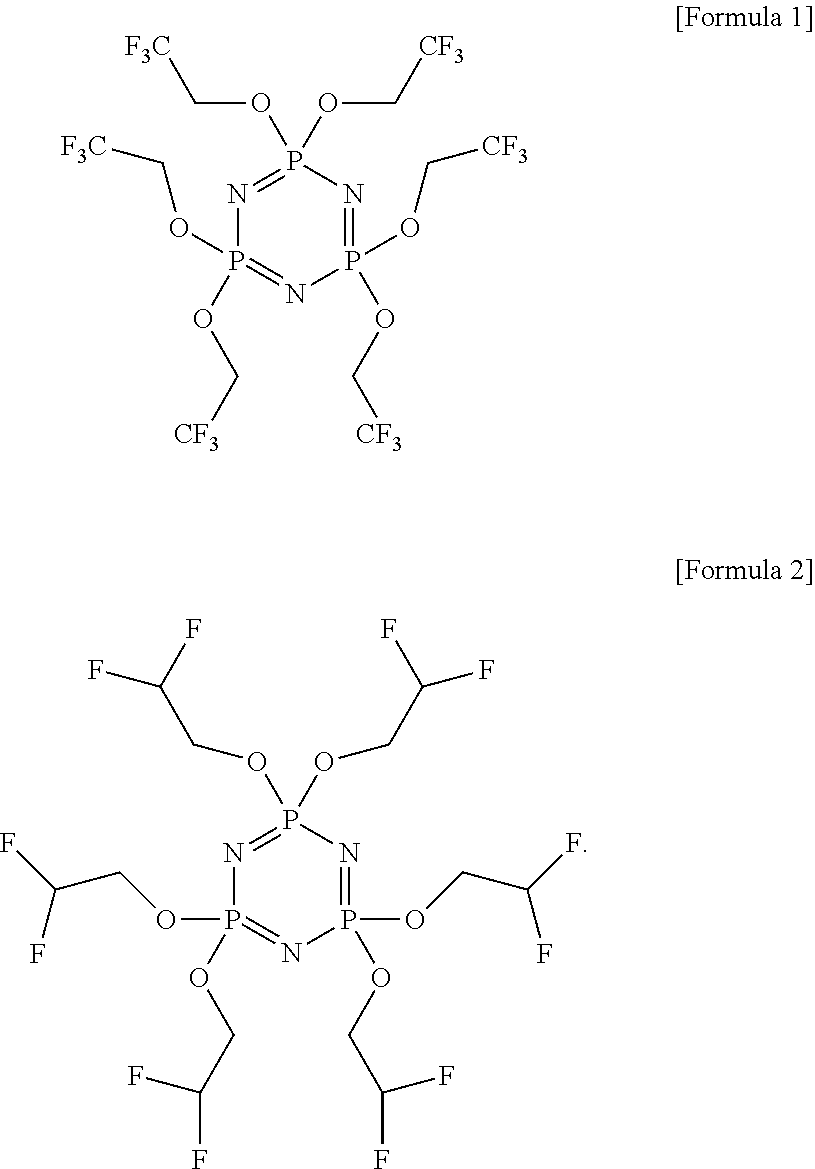Non-aqueous electrolyte solution and lithium secondary battery comprising the same
a technology of non-aqueous electrolyte and lithium secondary battery, which is applied in the direction of electrochemical generators, electrical apparatus, organic electrolytes, etc., can solve the problems of difficult to expect the improvement of low-temperature output characteristics and non-uniform sei formation, and achieve the effect of improving output characteristics, capacity characteristics, and output characteristics
- Summary
- Abstract
- Description
- Claims
- Application Information
AI Technical Summary
Benefits of technology
Problems solved by technology
Method used
Image
Examples
example 1
[0050][Preparation of Electrolyte Solution]
[0051]A non-aqueous electrolyte solution was prepared by adding LiPF6 0.1 mole / l, as a first lithium salt, and lithium bis(fluorosulfonyl)imide, as a second lithium salt, in a molar ratio of 1:9 and adding 3 wt % of the phosphazene-based compound of Formula 2 as a first additive, based on a total amount of the non-aqueous electrolyte solution to a non-aqueous organic solvent having a composition, in which a volume ratio of ethylene carbonate (EC):ethylmethyl carbonate (EMC) was 3:7.
[0052][Preparation of Lithium Secondary Battery]
[0053]A positive electrode mixture slurry was prepared by adding 92 wt % of LiCoO2 as a positive electrode active material, 4 wt % of carbon black as a conductive agent, and 4 wt % of polyvinylidene fluoride (PVdF) as a binder to N-methyl-2-pyrrolidone (NMP) as a solvent. An about 20 μm thick aluminum (Al) thin film as a positive electrode collector was coated with the positive electrode mixture slurry and dried, an...
example 2
[0056]A non-aqueous electrolyte solution and a lithium secondary battery were prepared in the same manner as in Example 1 except that LiPF6 0.125 mole / l, as the first lithium salt, and lithium bis(fluorosulfonyl)imide 0.875 mole / l, as the second lithium salt, were used in a molar ratio of 1:7.
example 3
[0057]A non-aqueous electrolyte solution and a lithium secondary battery were prepared in the same manner as in Example 1 except that the compound of Formula 1, instead of the compound of Formula 2, was used as the first additive, and LiPF6 0.143 mole / l, as the first lithium salt, and lithium bis(fluorosulfonyl)imide 0.857 mole / l, as the second lithium salt, were used in a molar ratio of 1:6.
PUM
| Property | Measurement | Unit |
|---|---|---|
| thick | aaaaa | aaaaa |
| thick | aaaaa | aaaaa |
| voltage | aaaaa | aaaaa |
Abstract
Description
Claims
Application Information
 Login to View More
Login to View More - R&D
- Intellectual Property
- Life Sciences
- Materials
- Tech Scout
- Unparalleled Data Quality
- Higher Quality Content
- 60% Fewer Hallucinations
Browse by: Latest US Patents, China's latest patents, Technical Efficacy Thesaurus, Application Domain, Technology Topic, Popular Technical Reports.
© 2025 PatSnap. All rights reserved.Legal|Privacy policy|Modern Slavery Act Transparency Statement|Sitemap|About US| Contact US: help@patsnap.com


